
|
Scientific Enlightenment, Div. One Book 2: Human Enlightenment of the First Axial 2.D.1. The example of the Yijing Metaphysics of Sung Dynasty, China Chapter 4. ACADEMY | previous section | Table of Content | next section | GALLERY |

|
Scientific Enlightenment, Div. One Book 2: Human Enlightenment of the First Axial 2.D.1. The example of the Yijing Metaphysics of Sung Dynasty, China Chapter 4. ACADEMY | previous section | Table of Content | next section | GALLERY |
copyright © 2003 by Lawrence C. Chin. All rights reserved.
With now all of the cosmogonic constituents at hand, the structure of the cosmos in its spatial and temporal aspect (the structure of space and time) can be made explicit. It is given in the simplistic form by the arrangement of the trigrams, already mentioned.
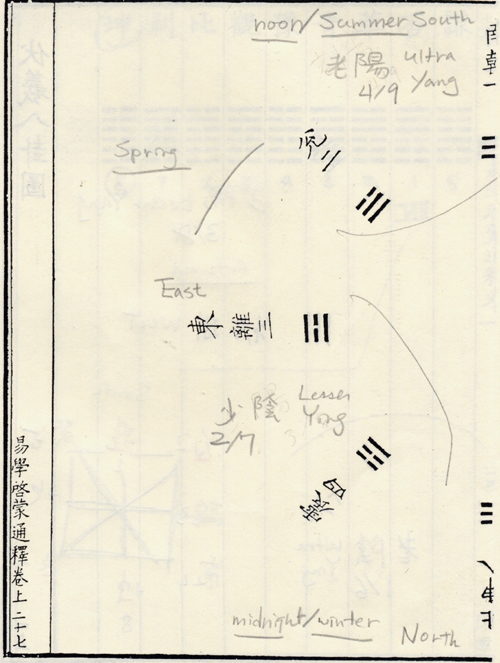
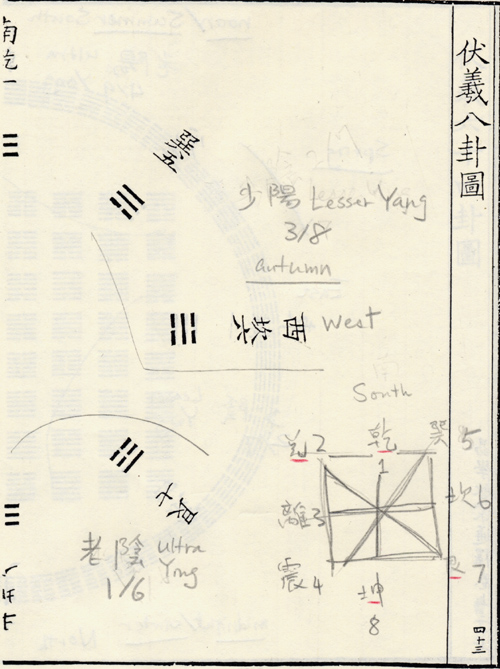
The top (south) is of course Qian and the bottom (north) Kun
, covered up by the gap of the facsimile. The structure of the space of the cosmos already discussed, this structure represents also its temporal structure, the turning of the 4 seasons with summer centered on Qian, the hottest and most existent, turning clockwise into autumn, centered around Kan
, which turns into winter centered on Kun, the coldest and least existent, which then turns into spring, centered around Li
and Dui
, slightly hotter and more existent (with only 1 line of Ying). It also represents the cycle of the day, with Qian on top, the hottest, being noon, and Kun at the bottom being midnight, the coldest. The trigrammatic structure, therefore, from 1 to 4 on the left and 5 to 8 on the right, is the general structure of the cosmos which manifests into the spatiality of the cosmos in manner already discussed, but also into its temporality twice over, first into the day and then into the year, i.e. temporality is a microcosm (day) in a macrocosm (year).
We have said (in the Introductory Synopsis of World Religions) that the essence of the perception of order in the functional perspective is microcosmo-macrocosmic concentricism: the same politea is to replicate itself on the diverse levels of reality. The Yijing metaphysics here is one most succinct expression of this: the same five-fold structure manifests, replicates, itself as the materiality, spatiality, and now even temporality of the cosmos twice over (or at least is supposed to so manifest -- the difficulty which the Chinese cosmologists encounter in reconciling the 5 elements with the 4 seasons will be discussed later). That spatiality and temporality recapitulate one another can of course take other forms, such as in the Near East where the spatial organization of society recapitulates the temporal structure of the cosmos which is furthermore taken in its other aspect than the seasonal: thus the Israelite ordering of agnatic descent groups in terms of 12 -- "In Genesis, not only Jacob had 12 sons, so did Nahor, Ishmael, and Esau" (Nancy Jay, Throughout Your Generations Forever, p. 151) -- recapitulates the 12 lunar months into which one cycle of time (year) is divided. ("Many ancient sacrificial calendars were based on 12 lunar months. Intercalary months or days were inserted to adjust the lunar year of 354 days to the solar year." Ibid.) Similarly, "[i]n Athens, before the reform of Kleisthenes, the 4 tribes each contained 3 phratries, and these in turn were divided into 30 gene. (A lunar month contains 29 and 1/2 days.)" (Ibid.)
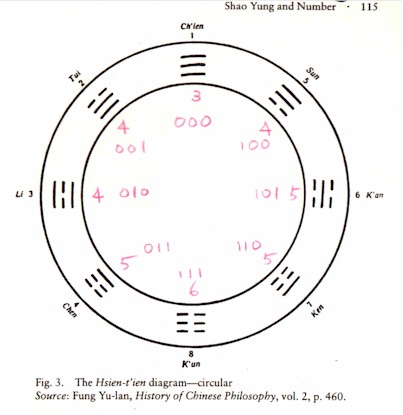 This arrangement of the trigrams as the pivotal constituents of the cosmos in its spatiality and temporality again, in its symmetry, conforms to certain conservational principle. As Kidder Smith (ibid., p. 114) has noted, the ying and yang can be taken as a binary number system used in computer language today. If Yang = 0 and Ying = 1, then Qian (with trigrammatic derivational number 1)
This arrangement of the trigrams as the pivotal constituents of the cosmos in its spatiality and temporality again, in its symmetry, conforms to certain conservational principle. As Kidder Smith (ibid., p. 114) has noted, the ying and yang can be taken as a binary number system used in computer language today. If Yang = 0 and Ying = 1, then Qian (with trigrammatic derivational number 1) = 000, Dui (2)
= 001, Li (3)
= 010, Zhen (4)
= 011, Xun (5)
= 100, Kan (6)
= 101, Gen (7)
= 110, and Kun (8)
= 111. The pair of trigrams across the circle always add up to 111. If, on the other hand, Ying = 2 and Yang = 1, then the numbers are 3, 4, 4, 5, 4, 5, 5, and 6. The pair then add up to 9 always. Assigning numbers to Ying and Yang is, in the conception established in the beginning, denoting the intensity of existence, so 0 and 1 mean more existence (and less spatiality) and 1 and 2 less existence (and more spatiality). 111 and 9 are therefore the total "amount" of existence and spatiality allowed for a given directional axis (north/south or summer/winter) of the differentiation of the primordial source (Taiji). Since the derivational numbers (Qian 1, Dui 2,... Kun 8) are not arbitrarily assigned but obtained through the diagram for the formula Ng = 2n, neither is the assignment of the pair of opposites any more arbitrary -- 1 to 4 and 5 to 9 are like mirror images of each other, except that instead of right changing to left, here ying changes to yang and vice versa -- the effect of symmetry and so conservation is generated entirely through the self-consistency of the system (the method whose quantitative formula is Ng = 2n). The total amount is the addition of (all) ying and (all) yang together (on a given axis, i.e. every axis must have 3 yangs and 3 yings, distributed in whatever proportion among the 2 poles), as to be expected given Taiji's original differentiation into the two. Incredibly yet, this so tightly self-consistent representational schema actually does capture the structure of the cosmos as seen in the functional perspective: the cycle of seasons, the alternation between hot and cold and their association with the cardinal directions, the sun vs. moon as correlative with the alternation of night and day, etc. In this manner of representation of the cosmos of the functional perspective, conservational principle/ symmetry is generated simply through self-consistency, what is called "beauty" in modern physics. Again in both cases symmetry must be expected because of conservational principle which is the immediately intuited law of nature. Compare, for example, the example which Fritjof Capra himself makes of the parallel between the hexagrammic circle and the meson octet (Tao of Physics, p. 283):
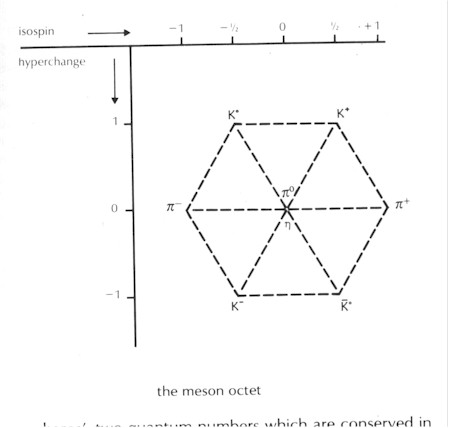
"Hadrons... carry definite values of 'isopin' [which for fermions, i.e. both hadrons and leptons, are always of half-integer value, e.g. +1/2, -1/2, +3/2, etc.; and for bosons always of integer value, e.g. -1, +1, etc.] and 'hypercharge', two quantum numbers which are conserved in all strong interactions. If the 8 mesons [formed from 2 quarks] listed... are arranged according to the values of these 2 quantum numbers, they are seen to fall into a neat hexagonal pattern known as the 'meson octet'. This arrangement exhibits a great deal of symmetry; for example, particles and antiparticles occupy opposite places in the hexagon, the two particles in the center being their own antiparticles. The 8 lightest baryons [formed from 3 quarks] form exactly the same pattern which is called the baryon octet. This time, however, the antiparticles are not contained in the octet, but form an identical 'anti-octet'. The remaining baryon in our particle table, the omega, belongs to a different pattern, called the 'baryon decuplet', together with 9 resonances. All the particles in a given symmetry pattern have identical quantum numbers, except for isospin and hypercharge which give them their places in the pattern. For example, all mesons in the octet have zero spin (i.e. they do not spin at all); the baryons in the octet have a spin of 1/2, and those in the decuplet have a spin of 3/2." (Capra, p. 253) In other words, the hadronic pattern of symmetry is such because, e.g. in the meson octet, the charges and spins of every pair have to add up to zero, the conserved amount. When the pure energy -- without charge and spin -- has to materialize as mesonic particles (via quarks, of course), it has to do so as pairs -- stretching from the center into an axis of two opposites! -- which are mirror image of each other.
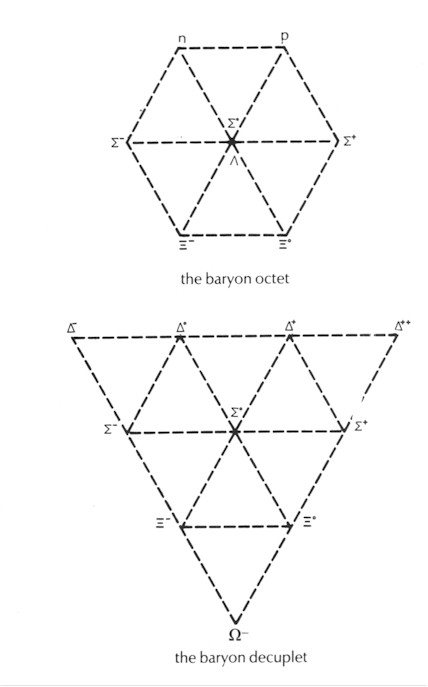
In the functional perspective of the Yijing metaphysics, the final reality of conservation is applied to the macroscopic orders of day and night and seasons and year, whereas in the structural perspective it exists only on the level of the subatomic particles. But the intuition about the conservational nature of reality remains the same. Hearken to Shao Yung's pronouncement on the trigrammatic circle: "Qian and Kun fix the positions up and down [the north-south and summer-winter axis]. Li and Kan set the gates of left and right. They are the opening and closing of heaven-and-earth, the exit and entry of the sun and moon. Spring, summer, autumn, and winter; the dark, new, crescent and full moon; the lengthening and shortening of days and nights; the expansion and contraction of cosmic rotations -- there is nothing that does not come from this! [The trigrammatic circle is the representation of all these, of the entire structure of the cosmos in a single image.]" (Cited by Smith, ibid., p. 116)
What the 64 hexagrams do is to add greater details to this structure.
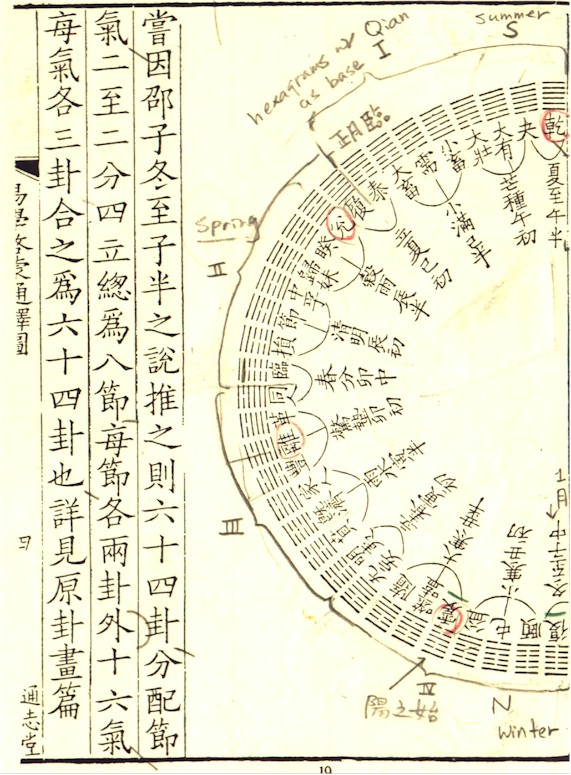
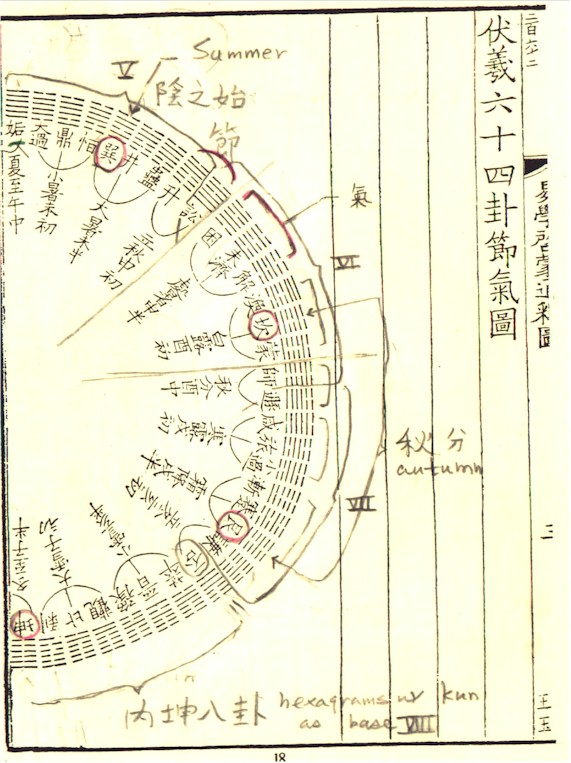
| On the ground of Zhao-Zi's saying of "winter reaching Zi3-Ban4" we [are able to] infer that the 64 hexagrams divide and equip jai2 (period 節) and qi4 (air 氣), 2 reaching 2's division into 4 thus established, totalling 8 jai2s. Every jai2 comprises 2 [hexa]grams outer-ly; the 16 qi4s each comprise 3 [hexa]grams, totalling 64 hexagrams. For details see the section on the original hexagramic representation. |
It is to be noticed that the first set of the 8 hexagrams in the derivation of the 64, those with Qian as the base, designated in the facsimile by I, clusters around the southeast corner or the general region of summer. The second set (II), those with Dui
as the base, around east or the general region of spring. The third set (III), those with Li
as the base, around east toward north, or the general region of the transition from winter to spring. The fourth set (IV) with Zhen
as the base, around the northeast, the more or less winter region. The fifth set (V) with Xun
as the base, around the southwest or the region of summer still. The sixth set (VI) with Kan
as the base, around the west, the general region of transition from summer to autumn. The seventh set (VII) with Gen
as the base around west toward north or the region of autumn. The last set (VIII) with Kun
as the base around north or the general region of winter.
Jai2 (period 節) and qi4 (air 氣) together constitute the 24 solar periods, finer determinations of the periods of a year. Each "period" takes 2 hexagrams and corresponds to the beginning of a season and the middle of it (equinox or solstice), and each "air" takes 3 hexagrams and corresponds to the seasonal periods in between. The hours of a day, designated traditionally by the 12 terrestrial stems (地支) and each equaling 2 hours (子 丑 寅 卯 辰 巳 午 未 申 酉 戌 亥 from 11 pm to 9 pm), when superimposed on the cycle of the year, each span 2 solar periods. In this way the quality of each of the hexagrams, its intensity of existence, represents also the hours of a day and periods of a year, in terms of correspondence of hot-light-more be-ing and cold-dark-less be-ing. A chart may be given of the 3-way correspondence, where "period" is numbered (1) and "air" (2) and the month designated, 2nd month of the year = 2m, etc.:
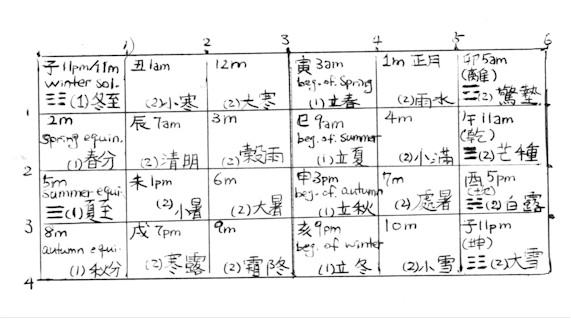
| ACADEMY | previous section | Table of Content | next section | GALLERY |